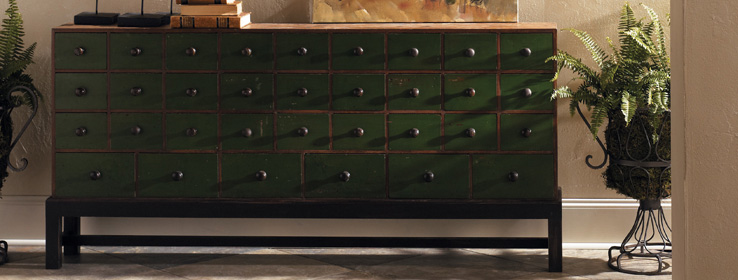Painting existing tables, chairs or bookcases also keeps old pieces from heading to the landfill.
Painting old or slightly shabby cabinets and furniture can breathe new life into the pieces – and create a dramatic accent in any room. Clients can realize many benefits from taking the repainting route – from aesthetic to environmental. "They can retain their existing good wood cabinets or other furniture, or possibly the fine workmanship of a former time," says designer Esther Sadowsky, owner of Charm & Whimsy in New York City. "Plus, a newer piece can have that new look again. Or, if the client appreciates the timeworn look of something being painted, then this is a great way to retain or bring back the original look."
On the flip side, some homeowners want their pieces to look new, and painting can achieve the appropriate style. Sadowsky cites the example of refinishing kitchen cabinetry, a popular choice among homeowners today, which results in another advantage: cost savings. "If a client wants high-gloss painted cabinets to look like they've been machine-sprayed and hard-finished, painting is a lot less costly," she notes. "Several coats of high-gloss paint with proper sanding in between coats, along with a hard-finished coat, can achieve a very similar look to the high-end factory ones."
For homeowners who are completely remodeling their kitchen, repainting cabinets can free up budget for other upgrades. "I take a high-low approach to design, where if you spend less in one area, that gives you the option to splurge in another," says Barbara Brown Roessler, an interior designer in Orlando. "Perhaps the client can buy that great ENERGY STAR-rated piece of equipment they might not have otherwise afforded unless they saved money on their cabinetry by repainting it."
Painting existing tables, chairs or bookcases also keeps old pieces from heading to the landfill. "If your client has cabinetry that's older or the finish has just vanished on it, for example, it's a great opportunity to save something that doesn't need to be demolished," says Brown Roessler, who adds that the availability of low- or no-VOC (volatile organic compounds) paints has encouraged her clients to repaint old furniture. "For so many years, we didn't realize how all of the chemicals we had been putting in our home and work environments impacted the quality of our air and our lives. More and more, my clients have responded to the chance of having a healthier situation" – and an aesthetically pleasing solution, too.
From a technical standpoint, designers need to employ the appropriate techniques to ensure a quality piece, including prepping and finishing. "For solid overall painting, knowledge of paints, brushes, finishes and the kinds of woods you are working with is very important," Sadowsky says.
What's more, she suggests that designers seek outside help when necessary. "If the designer is talented and qualified to do the work themselves, great, but if not, please hire a professional," such as a muralist or artist, she advises. "Remember that you are working on a client's own furniture, and you don't want to make a serious mistake that may be irreparable or costly."
Taking the path of repainting can introduce many new opportunities for designers. For one of her projects, Brown Roessler reproduced a client's favorite mural painting on the face of a cabinet. "It became a conversation piece," she says. The designer also takes care not to paint heirlooms. "You never want to take value away from a piece like that, but everyone has old things around their house, and it is amazing what you can do with them."
Sadowsky recalls one memorable project in which she painted over a large round dining room table that had seen better days. "The client owned a set of wonderful dinnerware that I replicated at each place setting in the exact colors," she says. "She then set the table as such, to the sheer delight of her guests. You cannot buy something like this to give an old piece a truly distinctive, fresh look."










